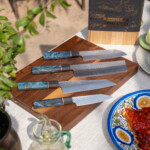The Only Knives You'll Ever Need
The Seki Kyuba KATA Set, featuring the Bunka, Nakiri, and Petty, is a specialised collection that caters to the discerning chef seeking unique Japanese blade shapes. This set offers a slightly more specialised chief knife in the form of the versatile Bunka, complemented by the vegetable-focused Nakiri and the precise Petty.
Each knife in this set boasts a VG10 steel core with a 3-layer construction, ensuring superior edge retention, ease of maintenance, and impressive durability. All blades feature a striking hammered finish, enhancing their functionality by reducing food sticking and adding a touch of artisanal beauty. The Bunka (18cm) offers enhanced precision with its reverse tanto tip, the Nakiri (18cm) excels in vegetable preparation, and the Petty (12cm) handles detailed tasks with finesse.
Available in Mediterranean Blue, Olive Green, and Natural Brown, this set combines exceptional performance with striking aesthetics. The handles, crafted from stabilised wood, provide a secure grip and add a touch of elegance to your kitchen arsenal.
This thoughtfully assembled set is ideal for the cook who wants to explore unique Japanese blade shapes while covering all bases in the kitchen. If you prefer a more traditional all-purpose chef’s knife, consider the Santoku, Nakiri, Petty set instead.


The Blades
The blade in the KATA line is designed to make cooking more enjoyable as cutting through produce will become an effortless task. The blade is handcrafted by skilled Japanese blacksmiths in Seki, Gifu village in Japan with high-quality VG10 high carbon stainless steel core, with a 3-layer construction. VG10 is a premium steel known for its excellent edge retention and corrosion resistance. The sharp blade is set in a premium-cut, waterproof stabilised maple burl wood available in Mediterranean Blue, Olive Green, or Natural Brown. The knife comes in a handcrafted, minimalist wooden box wrapped in a unique illustration strip.
VG10 steel offers an excellent balance between sharpness, durability, and ease of maintenance. The blade has a Rockwell Hardness rating (HRC) of 60-62, which ensures the edge remains sharp through regular use. This means you can enjoy consistent cutting performance with minimal upkeep. The blade allows for precise, effortless cuts, enhancing your overall cooking experience.
The Handles
The beautiful handles are made with extremely limited European maple burl dyed in an Natural Brown colour and feature a subtle copper ring under the oak bog wood kakumaki (collar of the handle). The wood has to be dried for two years before it undergoes the process of stabilisation. This ensures the wood is completely waterproof to avoid bacteria growth and is able to last generations.
The blade’s kakumaki (collar) is made with oak bog wood. A wood ranging from 2,500 to 5,000 years in age. Its age and living conditions give it a unique character and rich natural colour variation determined by its age. Giving you a knife with a rich history.
The stabilised premium-cut maple burl is shaped into an octagonal shaped ambidextrous handle to give you a firm grip on the knife. Not only are the handles aesthetically pleasing, they are also perfectly balanced, light and comfortable. This allows for maximum precision and more controlled movements during use.
No two handle colours or patterns are ever the same as the natural properties of each wood block are unique and will absorb the colour dye differently. This will give each knife a beautiful unique look and it can serve as an unforgettable gift.


The Blacksmith
The spirit of Samurai “Bushido” has never faded away from the history of Japan. The art of greatest sword smiths has been inherited through 780 years till now and it’s present in Japan’s Samurai Knife City, Seki in Gifu Prefecture, where Seki Kyuba knives are made by a famous blacksmith, Ozawa San.
High quality katana and kitchen blades are made with Japan’s traditional sword-smith technique and the latest technology, and are famed throughout the world today, especially high end kitchen knives.
Our partnership with one of the most talented and prominent blacksmiths of Japan resulted in Seki Kyuba kitchen knives, that are perfect for those that demand the highest quality. Being part of the Japanese knife community and owning a knife like this is a great honour and pleasure. We welcome you to Kyuba knives world.































































